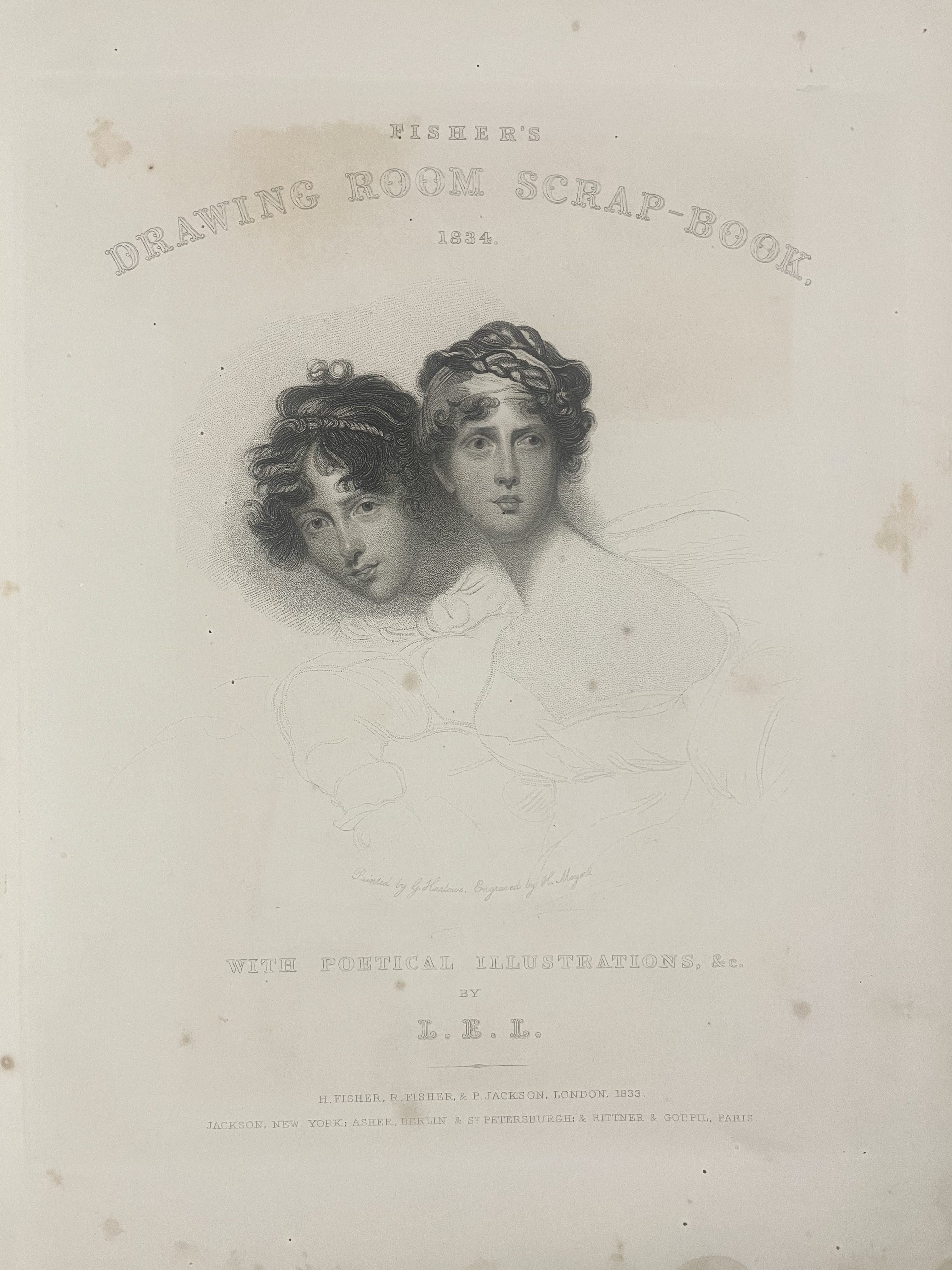Drawing Room Scrap Book

About
Summary
Exquisite
TOC
Details
Related
URL
Images
Overview
Fisher's Drawing Room Scrap Book was a popular and influential literary annual published in London by H. Fisher, R. Fisher, and P. Jackson from 1832 to 1854. The annual, notable for its engravings and accompanying poems or prose, offered readers a poetic and visual portal into foreign lands. It was successful enough to be distributed in New York, Paris, Berlin, and St. Petersburg.Published over 23 years, Fisher's Drawing Room Scrap Book was a product of Fisher, Son & Company, one of the leading publishers of illustrated books with steel engravings. Henry and Robert Fisher, a father-son duo, shifted their focus from religious works to illustrated topographical books after moving to London in 1821.
The annual was designed to be displayed in a drawing room, its name, appearance, and large size suggesting its role as a conversation piece and aesthetic object. Each volume contained 36 engravings, each accompanied by a poem or short prose piece, typically composed by the editor. These engravings often depicted architectural and landscape scenes from exotic places, offering readers an escape from the monotony of daily life.
The Drawing Room Scrap-Book was bound in quarter calf over blind-stamped cloth. The oversized quarto volumes, measuring approximately 11 inches high and 8.5 inches wide, contained around 70 pages and were sold for 21 shillings.
Importance of Book
Letitia Elizabeth Landon (L.E.L.): Edited the annual from 1832 to 1838. Landon was a prolific writer, contributing at least 527 poems to nineteen different annuals. She aimed to give the publication a high literary character.
Mary Howitt: Edited the annual for one year.
Sarah Ellis: Took over the editorship from 1843 to 18451. Ellis, also the editor of "Fisher’s Juvenile Scrap-Book," incorporated her moral and religious convictions into her work.
Caroline Norton: Served as editor from 1846 to 1849. Norton was a novelist, poet, and social activist who relied on periodicals and annuals for income.
Charles Mackay: Served as editor, and in his preface for the 1852 volume, he noted the "Drawing Room Scrap-Book's" long-lasting popularity.
Key Themes
The Drawing Room Scrap Book served as a poetic and visual portal into foreign lands. Its engravings of exotic places allowed readers to explore unfamiliar cultures. The themes explored in the annual were wide-ranging, reflecting both the engravings and the editor’s own agenda.
Landon’s contributions included poems such as “Sefton Church,” which explored themes of life, mistakes, and marriage. Norton’s “The Common Loss” depicted death as a peaceful culmination of life. The love poems often diverged from traditional metaphors, exploring painful heartbreaks with fresh perspectives.
Cultural Significance
The Drawing Room Scrap-Book was well-received and considered one of the superior literary annuals of its time. It was praised for its combination of exquisite engravings and original literary contributions.
The annual's success demonstrated the popularity of literary annuals in the 19th century as sources of entertainment and cultural enrichment. Its longevity, spanning over two decades, testified to the lasting quality of its literary and visual content. The "Drawing Room Scrap-Book" maintained its value, indicating the enduring appeal of its content
Effects on Society
The Drawing Room Scrap Book offered readers a means of escape and exploration. By presenting images and narratives of foreign lands, the annual broadened readers' cultural horizons and fostered an interest in the wider world.
The annual provided a platform for female writers and editors like Letitia Elizabeth Landon, Mary Howitt, Sarah Ellis, and Caroline Norton. These women used the "Drawing Room Scrap Book" to express their creativity, explore diverse themes, and share their perspectives with a wide audience. The success of the Drawing Room Scrap Book contributed to the recognition and validation of female writers in the literary marketplace.
The annual also played a role in shaping readers' perceptions of different cultures and societies. By presenting carefully selected images and narratives, the Drawing Room Scrap Book influenced readers' understanding of foreign lands and their inhabitants. The annual's focus on exotic places and cultures reflects the broader cultural interest in exploration and discovery during the 19th century.
Conclusion
Fisher's Drawing Room Scrap Book was a successful and influential literary annual that combined exquisite engravings with original literary contributions. Edited by prominent female writers, the annual offered readers a poetic and visual portal into foreign lands, broadening their cultural horizons and providing a platform for female voices. Its lasting legacy lies in its contribution to the literary annual genre and its ability to capture the imagination of readers during a transformative period in history.
Table of Content
The 1834 edition of \"Drawing Room Scrap Book\" typically includes:IntroductionOverview of the book\'s content and purpose.
Poetry and ProseA collection of poems, short stories, and essays suitable for drawing-room reading.
MusicMusical compositions or lyrics for popular songs of the time.
Art and IllustrationsEngravings, illustrations, or sketches related to the text.
Social and Cultural CommentaryObservations on contemporary society, manners, and customs.
Recipes and Household TipsRecipes for culinary dishes and practical household advice.
MiscellaneousAdditional content such as anecdotes, quotes, or humorous pieces.
IndexIndex for referencing key topics and contributors.
Title
Drawing Room Scrap Book
Author
LEL H Fisher, R Fisher & P Jackson
Name of Publisher
London H Fisher son and co printers
Publish Date
1834
Subject
This collection is designed to provide entertainment and cultural insight for readers of the era.
Vintage
1801-1900
Category
Fiction
Sub Category
Fantasy
Rarity
RARE
